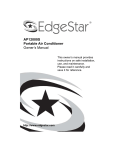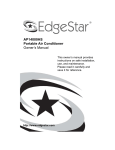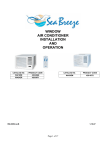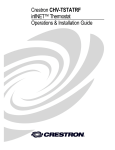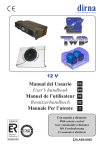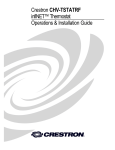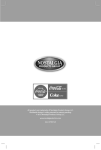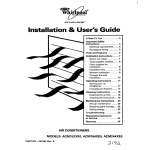Download Seabreeze WH12ZM Operating instructions
Transcript
WINDOW AIR CONDITIONER INSTALLATION AND OPERATION CATALOG NO. WH12ZM PRODUCT CODE 420-0074 950-0053-revA 11-09-06 Page 1 of 20 TABLE OF CONTENTS AIR CONDITIONER SAFETY………………………………………………………………………………………….2 NORMAL CARE & MAINTENANCE………………………………………………………………………………….3 INSTALLATION REQUIREMENTS…………………………………………………………………………………..5 ELECTRICAL REQUIREMENTS……………………………………………………………………………………..6 INSTALLATION INSTRUCTIONS……………………………………………………………………………………8 THROUGH-THE-WALL CABINET INSTRUCTIONS-----------------------------------------------------------------------11 THRU-WALL INSTALLATION INSTRUCTIONS----------------------------------------------------------------------------13 GENERAL OPERATING INSTRUCTIONS…………………………………………………………………………16 TROUBLESHOOTING………………………………………………………………………………………………...18 SPECIFICATIONS……………………………………………………………………………………………………..19 WARRANTY………………………………………………………………………………………………………...….20 TECHNICAL SUPPORT IF YOU NEED TECHNICQL SUPPORT, PLEASE CALL (705) 504-8590 BETWEEN THE HOURS OF 8:OO A.M. TO 5:00 P.M. EST. PLEASE HAVE YOUR EQUIPMENT MODEL NUMBER AND SERIAL NUMBER AVAILABLE WHEN YOU CALL. AIR CONDITIONER SAFETY Your safety and the safety of others are very important We have provided many important safety messages in this manual and on your appliance. Always read and follow all safety instructions. This is the safety alert symbol. This symbol alerts you to potential hazards that can kill or hurt you and others. All safety messages will follow the safety alert symbol and word “DANGER” Or “WARNING” These words mean: You can be seriously injured if instructions are not followed. Bodily injury or damage to personal property may occur if instructions are not followed. All safety messages will tell you what the potential hazard is, tell you how to reduce the Chance of in jury, and tell you what can hap pen if the instructions are not followed. Page 2 of 20 INSTALLATION Complete step-by-step installation instructions are furnished with your unit. These instructions will be found on a separate page included with this manual or in the mounting kit assembly. Follow these instructions carefully. Keep these instructions with this manual for future reference. Your unit will be one of the following designs: • Unit with a window mounting kit These models are designed for mounting through an opening in a wall. These units can be adapted to window installation by using the optional window mounting kit supplied with your unit. Electrical Requirements Grounding Instructions This appliance is equipped with a three-prong grounding plug for protection against possible shock hazards. If a two-prong wall receptacle is encountered, the customer is required to contact a qualified electrician and have the two-prong wall receptacle replaced with a properly grounded threeprong wall receptacle in accordance with the National Electrical Code. Room air conditioners are designed to operate according to the requirements on the nameplate and as shown in Table 1. Fuse or circuit breaker ratings must be according to the fuse instruction label and as shown in Table 1. Do not plug models marked “Use on Single Outlet Circuit Only” into a circuit with another appliance or light fixture. Receptacle Wiring Receptacle wiring must be of adequate size for unit. Refer to unit identification plate for exact power requirements. Minimum size of wiring, based on power requirements, is: Units up to 20 amps: 12 gauge 20-30 amp units: 10 gauge LCDI or AFCI Power Cords Underwriters Laboratories (UL) and the National Electric Code (NEC) now require power cords that sense current leakage and can open the electrical circuit to the unit. In the event the unit does not operate, check the reset button located on or near the head of the power cord as part of the normal troubleshooting procedure. Use copper wire only. The consumer’s responsibility is to provide proper and adequate receptacle wiring that conforms to all applicable codes. All wiring should be installed by a qualified electrician. • Unit without a window mounting kit No window mounting kit is supplied with the unit. These models are designed for mounting through an opening in a wall. These units can be adapted to window installation by purchasing an optional window mounting kit. Consult your dealer to choose the kit that is appropriate for your model and installation. ROOM AIR CONDITIONER/HEATING UNITS Heat model is by electric heating elements. See specification sheet for electrical data information. NORMAL CARE AND MAINTENANCE Annual Inspection It is suggested that your unit be inspected by your dealer or contactor once a year. It is advisable to have the outer case removed and the unit thoroughly cleaned. NOTE: The life of your unit may be greatly reduced if you live in a salt air or other corrosive type environment. Under these conditions, the unit should be removed from its case and completely cleaned at least once a year. At that time any scratches or blisters on the painted surfaces should be sanded and repainted. Placing an algaecide tablet in the outdoor side of the unit’s base-pan is suggested in humid areas where algae formation is common. Page 3 of 20 Front Grill and Filter Removal Fan Motor Care The front contains an air filter that can be removed on the left or right side of the front. To clean the filter use the following method for filter removal: The fan motor is permanently lubricated for long life. There is no need to oil the motor. Slide-out Chassis Removal from Outer Case 1. Remove two side Phillips screws attaching case to chassis base-pan. 2. Remove two control knobs. 3. Remove two side Phillips screws attaching front panel to case. 4. If the unit has a screw holding the base-pan clip to the chassis, remove the screw. 5. Using base-pan handle, pull chassis straight out, slowly and evenly, until approximately 9 – 12 inches extends from outer case. Use both hands to grasp base-pan and pull remaining chassis from outer case. Grasp filter handle and slide filter out of unit. NOTE: Base-pan clip is shipped in plastic bag with mounting screw and condensate drain cup. Install clip after reinserting chassis into outer case to prevent accidental chassis removal. Reinstall air filter by reversing removal procedure. Front Grill and Cabinet Cleaning Grill and cabinet may be cleaned with warm water and mile soap or detergent. Cleaning and polishing compounds are not recommended as they may damage plastic surfaces. Air Filter Cleaning A dirty air filter reduces operating efficiency of unit. Filter should be inspected at least once every week during operation. Clean filter with vacuum cleaner or wash in warm water and mild detergent. Filter should be thoroughly dried before replacing in unit. Do not operate unit without filter in place. Page 4 of 20 IMPORTANT SAFETY INSTRUCTIONS To reduce the risk of fire, electrical shock or injury when using your air conditioner, follow these basic precautions: • Plug into a grounded 3 prong outlet • Do not use an extension cord. • Do not remove ground prong. • Unplug air conditioner when servicing • Do not use an adapter • Use two or more people to move and install air conditioner. WARNING: ________________________________________________________________________________________ INSTALLATION REQUIREMENTS ________________________________________________________________________________________ Tools and Parts Gather the required tools and parts before starting installation. Read and follow the instructions provided with any tools listed here. Tools Needed • Flat-blade and Phillips screwdriver • Tape measure • Drill and 3/16” or smaller bit • Level Through-the-wall installation: In addition to the tools listed above, the following tools are needed for through-the-wall installation: • Saw • Wood Preservative • Caulk • 1” (2.5cm) or thicker lumber • 7 - #10 x 1” wood screws Parts supplied (on some models) Check that all parts are included in parts package NOTE: Installation parts are supplied for doublehung windows up to 40” (101.6cm) wide. Page 5 of 20 Location Requirements IMPORTANT: observe all governing codes and ordinances. Check the location where air conditioner will be installed. Proper installation is your responsibility. Make sure you have everything necessary for correct installation. The location should provide: • Grounded electrical outlet within 4 ft (122cm) of where the power cord exits the air conditioner. Note: Do not use an extension cord. • Free movement of air in room to be cooled. • A large enough opening for the air conditioner. • Adequate wall support for weight of air conditioner. Air conditioner weighs between 94 and 103 lbs (43 to 47kg). NOTE: Cabinet louvers must not be obstructed. Air must be able to pass freely through the cabinet louvers. _______________________________________ Window Installation _______________________________________ Window opening measurements: • 27” min to 38” max (68.6 cm to 95.5 cm) opening width. • 16 ¼ min (41.3 cm) opening height. Electrical Requirements _ ______________________________________ Through-the-wall Installation _______________________________________ The wall opening measurements should be: • Height: 15 9/16” (39.5cm) plus twice the thickness of wood used to build frame. • Width: 22 13/16” (57.9 cm) plus twice the thickness of wood used to build frame. Page 6 of 20 Ground wire must be connected to ground screw located in lower right corner of air conditioner when air conditioner is in cabinet. The electrical ratings for your air conditioner are listed on the model and serial number label. The model and serial number label is located behind the front panel on the flange below the control panel area. Specific electrical requirements are listed in the chart below. Follow the requirements for the type of plug on the power supply cord. _______________________________________ Recommended grounding method _______________________________________ This air conditioner must be grounded. This air conditioner is equipped with a power supply cord having a grounded 3 prong plug. To minimize possible shock hazard, the cord must be plugged into a mating, grounded 3 prong outlet, grounded in accordance with all local codes and ordinances. If a mating outlet is not available, it is the customer’s responsibility to have a properly grounded 3 prong outlet installed by a qualified electrical installer. It is the customer’s responsibility: • To contact a qualified electrical installer • To assure that the electrical installation is adequate and in conformance with National Electrical Code, ANSI/NFPA 70- latest edition, and all local codes and ordinances. Copies of the standards listed may be obtained from: National Fire Protection Association One Batterymarch Park Quincy, MA 02269 _______________________________________ Power Supply Cord _______________________________________ NOTE: YOUR UNIT’S DEVICE MAY DIFFER FROM THE ONES SHOWN. This room air conditioner is equipped with a power supply cord required by UL. This power cord contains state-of-the-art electronics that sense leakage current. If the cord is crushed, the electronics detect leakage current and power will be disconnected in a fraction of a second. Page 7 of 20 To test your power supply cord: 1. Plug power supply cord into a grounded 3 prong outlet. 2. Press RESET 3. Press TEST (listen for click; Reset button will trip and pop out). 4. Press and release RESET (listen for click; Reset button will latch and remain in). The power supply cord is ready for operation. NOTES: • The Reset button must be pushed in for proper operation. • The power supply cord must be replaced if it fails to trip when the test button is pressed or fails to reset. • Do not use the power supply cord as an off/on switch. The power supply cord is designed as a protective device. • A damaged power supply cord must be replaced with a new power supply cord obtained from the product manufacturer and must not be repaired. • The power supply cord contains no user serviceable parts. Opening the tamperresistant case voids all warranty and performance claims. ___________________________________________________________________________________________ INSTALLATION INSTRUCTIONS ___________________________________________________________________________________________ UNPACKING 3. Remove front panel by removing 2 Phillips screws on both sides. 4. Remove both knobs from control panel. 5. Remove ground screw and ground wire from front of air conditioner base. Save ground screw. Remove packaging materials. • Remove and dispose or recycle all packaging materials. • Remove tape and glue residue from surfaces before turning on the air conditioner. Rub a small amount of liquid dish soap over the adhesive with your fingers. Wipe with warm water and dry. • Do not use sharp instruments, rubbing alcohol, flammable fluids, or abrasive cleaners to remove tape or glue. These products can damage the surface of your air conditioner. • Handle air conditioner gently. 6. Pull on handle to slide air conditioner out of cabinet. Place air conditioner on cardboard. 1. Remove air conditioner from carton and place it on cardboard. 2. Remove shipping screws from both sides of cabinet. NOTE: Do not lift, push, pull or remove any expanded polystyrene (foam) from inside the air conditioner. It is not packing material. ________________________________________________________________________________________ WINDOW INSTALLATION (on some models) NOTES: • Place top channel on top of air conditioner • Handle air conditioner gently cabinet, lining up the 3 holes in top channel with 3 holes on top of air conditioner cabinet. • Be sure your air conditioner cabinet does not • Using 3 - #10 x 3/8” pan-head Phillips screws, fall out of the opening during installation or attach top channel to air conditioner cabinet. removal. • The location where the power cord exits the air conditioner should be no more than 4 ft (122cm) from a grounded 3 prong outlet. • Do not block the louvers on the front panel. • Do not block the louvers on the outside of the air conditioner. _________________________________________ Attach Top Channel NOTE: Attach top channel and side curtains to air conditioner cabinet before placing cabinet in window. • Locate supplied bag of screws. Page 8 of 20 Attach side curtains 1. Locate provided bag of screws 2. Insert top and then bottom of right-hand curtain housing in top and bottom curtain guides on air conditioner cabinet. 5. Slide curtain housing into guides as far as it will go. 6. Repeat above steps for left-hand curtain. _________________________________________ Attach Foam Adhesive Seal Back View Bottom View 3. Extend right-hand curtain outward so you may insert the first screw through the middle hole of the curtain. Using #10 x ¼” pan-head Phillips screw, screw curtain to middle hole in air conditioner cabinet. NOTE: This screw is required to correctly attach curtain (top to bottom) to the air conditioner cabinet. _________________________________________ Install Cabinet into Window • Handle air conditioner gently. • Be sure your air conditioner cabinet does not fall out of the opening during installation or removal. • The location where the power cord exits the air conditioner should be no more than 4 ft (122cm) from a grounded 3 prong outlet. • Do not block the louvers on the front panel. • Do not block the louvers on the outside of the air conditioner. 1. Center empty cabinet in window. Check that lower rail of air conditioner cabinet is behind and against back side of windowsill. Maintain a firm hold on the air conditioner cabinet. Lower window sash to hold cabinet in place. Top channel must be on inside room of window sash. 4. While the right hand curtain is still extended, insert #10 x ¼” pan-head Phillips screws into the top and bottom slots of curtain. Screw Curtain to the top and bottom holes in air conditioner cabinet. NOTE: Some curtains may have 2 slots on each end. You will be able to see a mounting hole through the correct slot. Page 9 of 20 2. Measure the distance between the right-hand side of the cabinet and the inside of the window channel 3. Repeat for left side. Adjust the cabinet until the distance on each side is the same. _______________________________________ Attach Side Curtains to Window Frame 1. Pull left-hand curtain out until it fits into window channel. Use a 3/32” drill bit to drill a starter hole through the hole in the curtain housing and into the lower window sash. Front View 4. Use a 3/16” drill bit to drill 3 starter holes ½” deep through the 3 holes in the cabinet and into the window sill. 5. Attach cabinet to windowsill with 3 - #10 x ½” pan-head Phillips screws. Top View 6. Check that the air conditioner cabinet is tilted ½ bubble on carpenters level to the outside so that water will run to the outside. 2. Insert one of the #10 x ¾” round-head screws through hole and into lower window sash. Insert one of the #10 x ¾” round-head screws through threaded hole in top of curtain and one in bottom of curtain. 3. Repeat for right-hand curtain. Page 10 of 20 Option 1 – Wood, metal or plastic molding When you are using wood, metal or plastic molding, the wood frame should line up with inside wall as shown. Complete Window Installation 1. Insert foam seal behind the top of the lower window sash and against the glass of the upper window. 2. Place window-lock bracket on top of lower window and against upper window sash. 3. Use a 3/32” drill bit to drill a starter hole through the hole in the bracket and into the window sash. 4. Attach window-lock bracket to window sash with #10 x ¾” round-head screw to secure window in place. Option 2 – Plastered wall with no molding If the plastered wall is to be flush with the cabinet and no molding is used, the wood frame must be set ½” (13mm) into the inside wall. _______________________________________ Through-the-wall Cabinet Installation _______________________________________ NOTES: • Handle air conditioner gently. • Be sure your air conditioner cabinet does not fall out of the opening during installation or removal. • The location where the power cord exits the air conditioner should be no more than 4 ft (122cm) from a grounded 3 prong outlet. • Do not block the louvers on the front panel. • Do not block the louvers on the outside of the air conditioner. • It is the customer’s responsibility and obligation to have this product installed by a qualified technician familiar with through-thewall room air conditioner installations. Install Wood Frame 1. Construct wood frame. See “Location Requirements” for dimensions. 2. Measure outside width and height of frame to determine wall opening dimensions. 3. Cut opening through the wall. Remove and save insulation. NOTES: • Dimension for depth depends on wall thickness and type of molding. • Do not block louvers in air conditioner cabinet. • Use 1” (2.5cm) or thicker lumber for wood frame. Page 11 of 20 5. use existing holes and 6 - #10 x 1” wood screws (not provided) to attach cabinet to frame. NOTE: Do not over-tighten screws or cabinet will distort and provide a poor air seal between cabinet and air conditioner. 6. Caulk all outside wall openings around cabinet. NOTE: Handle air conditioner gently. 1. Make sure the free end of the ground wire is outside of the cabinet. 4. Apply wood preservative to the outside exposed surface. 5. Insert the frame in the wall opening. Square and level frame. 6. Attach frame securely to the wall. Install Cabinet into Wood Frame 1. Insert cabinet into the framed wall opening. The top of the cabinet should extend ½” (13mm) into the room. If there is trim, the cabinet should extend ½” (13mm) past the trim. 2. Use a level to check that cabinet is level side to side. 3. Check that air conditioner cabinet is tilted to the outside so that water will run to the outside. ½ bubble on carpenter’s level. Reuse the insulation to seal opening between cabinet and frame. 4. 2. Insert air conditioner into cabinet. REMEMBER: make sure the free end of the ground wire is outside of the cabinet. 3. Connect green ground wire to cabinet base with ground screw. Page 12 of 20 4. Position Ground wire pointing straight up. Put excess ground wire between coil and air conditioner cabinet. 5. 6. Install shipping screws on both sides of cabinet. Insert front tabs of front panel into top of cabinet and swing front into place. Attach bottom front of panel with front panel screws. Replace control knobs (on some models). 7. NOTE: For through-the-wall installations, if needed, install molding around room side of cabinet. 8. 9. Plug into a grounded 3 prong outlet. Press RESET on the power supply cord. ___________________________________________________________________________________________ Thru-Wall Installation Instructions Introduction This instruction sheet provides guidelines for installing a compact air conditioner through an outside wall. Air Conditioner Dimensions The following figures show the outside dimensions of air conditioner with chassis installed, and dimensions of outer case with chassis removed. Page 13 of 20 Air Conditioner Dimensions (with chassis installed) Dimensions of finished opening Outer Case Dimensions (chassis removed) General Instructions All compact room Air conditioners feature a slide-out chassis. Chassis and front cover must be removed from outer case for installation. Masonry Construction See CAUTION under General instructions. In masonry walls, cut or build a finished opening 15 9/16 inches high by 22 13/16 inches wide. When case is properly positioned in opening, secure it in place with mortar or concrete nails driven through holes in sides of outer case (shim case and pre-drill holes before securing with nails). Brick Veneer or Frame wall Construction See CAUTION under General instructions. Cut or build rough opening large enough to allow a framed, finished opening 15 9/16 inches high and 22 13/16 inches wide. When case is properly positioned in opening, secure it to framing material with nails or screws driven through holes in sides of outer case (shim case and pre-drill holes before securing). A finished opening 22-13/16” wide x 15 9/16” high is recommended. The lower left inside corner of opening must be within 5 feet of an appropriate electrical outlet. (see Use and Care manual for electrical requirements). When wall thickness exceeds 8-1/2 inches, opening must be modified to allow air to enter side louvers on case (see special instructions on back). Do not install air conditioner in walls thicker than 11-3/4”. Framed/Finished Opening (brick veneer or frame wall construction) Page 14 of 20 Placement of Outer Case in Opening Place outer case in opening, flush against one side of opening. Use carpenter’s level and ensure case is level from side to side and has a 3/8 inch slope from front to back (back of case must be 3/9 inch lower than front to ensure proper condensate drainage). If needed, use shims to level case (from side to side) and to obtain proper back slope. Installation in Wall Thicker than 8 – ½ Inches The side louvers in outer case provide ventilation to air conditioner compressor and fan motor and must not be blocked. When installing unit in a wall over 9 3/8” thick, provisions must be made in wall opening to ensure free air flow to the side louvers. This can be accomplished by chamfering the vertical portions of the outside opening as shown. Front of case must project ¾ inch (minimum) beyond inside wall in order to attach air conditioner front frame. If framing indoor side of opening with wood molding (or other decorative material), extend outer case ¾ inch beyond molding. Ventilation louvers on top of case must not be obstructed. Do not attempt to install unit in walls thicker than 11-3/4 inches. When case is properly positioned in opening, use wood shims to fill any gaps between case and finished opening, especially in area where case will be secured to opening. Take care not to warp or distort case when installing shims. For condensate drainage, install drainage cup in drain hoe on baseplate of case. Installed Case (brick veneer or frame wall construction shown) Page 15 of 20 GENERAL OPERATING INSTRUCTIONS ___________________________________________________________________________________________ While operation of all units is similar, controls vary slightly from model to model. Operating Controls section shows control panel of unit purchased and gives detailed information about operation of controls. Airflow Around Unit Select the highest fan speed and set temperature control to its coldest position. When the desired temperature is reached, slowly move the temperature control toward a warmer setting until the compressor shuts off. The thermostat will then cycle the compressor on and off to maintain this selected temperature. Adjust the fan speed for desired air circulation. However, in very humid conditions excess amounts of water may drip off the unit chassis. If this proves to be a problem, install the condensate drain cup included with the unit to route excess water where it would not be a problem (see illustration). To install, remove the unit chassis from the outercase. Insert the condensate drain cup through the recessed ½” hole on the back center of the outercase. Once inserted, place a ½” diameter hose or tube on the drain cup bottom spout. The hose allows you to route where you want the excess water to go. Reinsert the unit chassis into the outercase. The unit basepan overflow hole will be positioned directly above the drain cup and will catch any water that might run out. Changing airflow Direction Baffles Airflow on unit may be diverted left or right from center by baffles. Upward and downward air discharge is provided by tilting louvers. Adjust baffles and tilt louvers for desired airflow pattern. Airflow Around Unit Check the indoor grill and outdoor louvers for obstructions to airflow. Do not block the airflow to and from the unit. If air is obstructed and/or deflected back into the unit, the air conditioner’s compressor may cycle off and on rapidly. This could damage your unit. Drain Cup Installation and Use Your air conditioner uses a system where the water removed from the indoor air (condensate) is channeled to the outdoor side of the unit. The outdoor fan blade has a “slinger” ring attached to it that dips into the water and slings the water onto the outdoor coil surface. This is the sound of water you hear during normal operation. The water quickly evaporates on this warm surface and improves the efficiency of your air conditioner. In normal conditions the unit can evaporate the water as fast as it is removed from the indoor air. Page 16 of 20 Operating Controls Fan Control OFF Completely shuts off the unit. To prevent blowing fuses, wait two minutes after turning the unit off before turning it on again. LOW COOL Filters and circulates room air with the fan running continuously on low speed. Also cools and dehumidifies while the compressor is running. Select this setting for quiet cooling operation. HIGH COOL Filters and circulates room air with the fan running continuously on high speed. Also cools and dehumidifies while the compressor is running. Select this setting for maximum air circulation and cooling effect. LOW HEAT Filters and circulates room air with the fan running continuously on low speed. Also heats while the compressor or electric heat is running. Select this setting for quiet heating operation. Temperature Control Turn this control to the left for a warmer room temperature, to the right for a cooler temperature. Vent Control (On Some Models) Choose one of the following two settings by sliding the vent control under the appropriate marking: EXHAUST Exhausts room air to the outdoors. Also circulates and filters room air. This position can be used to exhaust stale or smoky air. To conserve energy, it is advised that the Fan Control be in the Fan Only setting when using this feature. CLOSED Exhaust damper is closed. Unit circulates and filters room air. This position should be used for normal cooling operation. HIGH HEAT Filters and circulates room air with the fan running continuously on high speed. Also heats while the compressor or electric heater is running. Select this setting for maximum air circulation and heating effect. FAN ONLY Select this setting for circulating or exhausting room air without cooling. Page 17 of 20 TROUBLESHOOTING The following is a list of problems that are sometimes encountered when using a room air conditioner. Possible cause and suggested remedies are given for each problem. • UNIT WILL NOT RUN Push reset button on power cord. Set Fan control to position other than OFF. Make sure plug is firmly seated in outlet. Check for blown fuses, tripped circuit breakers. • LITTLE OR NO COOLING OR HEATING, (Fan and Compressor run) Set vent to CLOSED Remove obstruction from indoor grill or outdoor louvers. Dirty air filter. Clean or replace as needed. Check with dealer to determine proper capacity unit for application. • LITTLE OR NO COOLING OR HEATING, (only fan runs) For cooling, turn Temperature Control to cooler setting. For heating, turn Temperature Control to warmer setting. • NOISY UNIT Tighten any loose parts Provide additional support for unit. Normal in high humidity. Stop noise by removing drain plug or adding condensate drain cup. Check with dealer to determine proper capacity unit for application. Page 18 of 20 • MOUNTING SUPPORT NOT INSTALLED Some models require removal of storm window frame before installation. • FROST ON INDOOR COIL Clean air filter by vacuuming or washing with water and mild soap. Turning Temperature Control to warmer setting reduces occurrence and duration of frost. • ODORS IN COOLING To reduce algae growth, use an algaecide tablet in base pan; remove drain plug; add condensate drain cup and hose. Thoroughly clean unit. • ODORS IN HEATING Caused by dust accumulation during unused months. Odor dissipates quickly with heater use. TECHNICAL SPECIFICATIONS MODEL BTU COOLING BTU HEATING EER RATING WH12ZM 11600 – 11200 10700 – 8500 9.8 DEHUMIDIFICATION (pints/hour) AIRFLOW (CFM) VOLTAGE FREQUENCY AMPS COOLING AMPS HEATING WATTS COOLING WATTS HEATING PLUG TYPE POWER CORD RATING (amps) POWER CORD TYPE POWER CORD LENGTH REFRIGERANT REFRIGERANT CHARGE (oz. / lbs) SOUND (INSIDE/OUTSIDE) dba (MAX) 4 WAY AIR ADJUSTMENT 2 WAY AIR SWING AIR DISCHARGE MOTOR TYPE MOTOR CAPACITOR CONTROLS THERMOSTAT TEMP ºF CABINET SIZE (INCHES) WIDTH DEPTH HEIGHT WINDOW OPENING THRU WALL MAX THICKNESS WEIGHT / lbs (GROSS/NET) APPROVALS TABLE 1 Page 19 of 20 2.6 310 (MAX) 230 - 208 VAC 60 HZ 5.2 – 5.7 14.84 – 13.42 1164 – 1133 3500 Type B 20 LCDI 6’ R22 32.32 / 2.02 58 / 62 YES YES TOP BALL BEARING 4 µfd MECHANICAL 61ºF to 89ºF 11 ½” 23 ½” 15 ⅜” 28” – 44” 5½ 114 / 97 UL/ CUL WARRANTY International Refrigeration Products warrants that the product supplied is free from defects in material and workmanship. This warranty is valid as long as this product is properly handled, installed, operated and serviced in accordance with the Installation and Operating Instructions shipped with this unit, and the warranty card is completed and mailed no later than 30 days after date of purchase. All warranty claims must be made within one (1) year (five (5) years for compressor) from date of purchase (unless national regulations require a longer registration period). This warranty provides free replacement of defective parts only. Labor and replacement parts as a result of normal wear and tear are not covered under this warranty. Additional claims are excluded, unless required by national regulations. International Refrigeration Products Inc. is not responsible for incidental, consequential, direct, or indirect damages or expenses relating to the use of, or the inability to use the product for any purpose. Other implied warranties are excluded. This constitutes International Refrigeration Products warranty obligation and replaces any and all prior warranties for this product. INTERNATIONAL REFRIGERATION PRODUCTS INC. 11325 Nations Ford Rd., Charlotte, NC 28134-8393 (704) 504-8590 Phone (704) 504-3023 Fax Copyright 2006 IRP Inc. 950-0053 Page 20 of 20




















